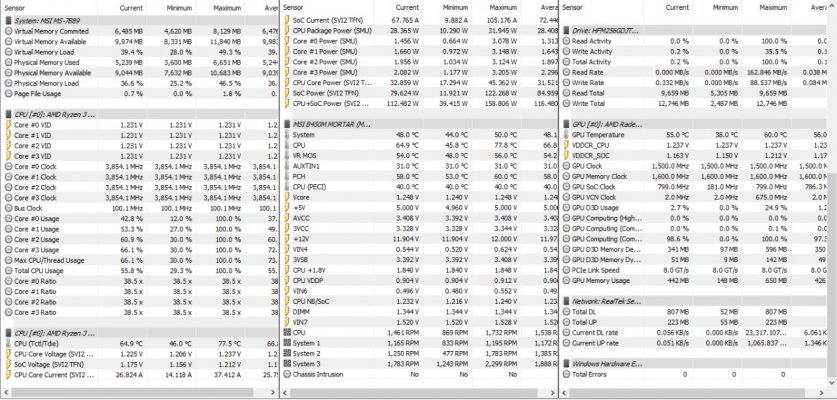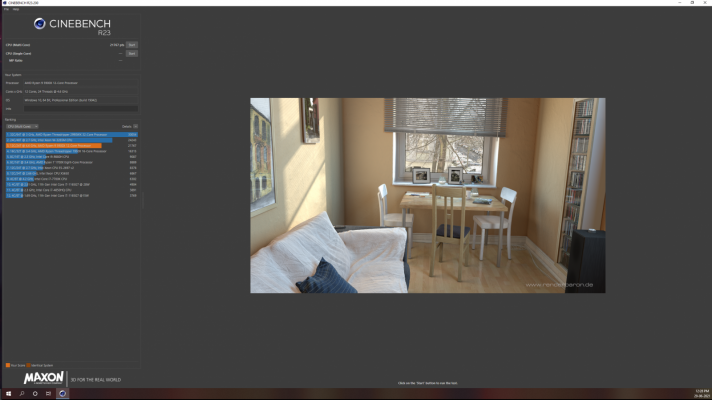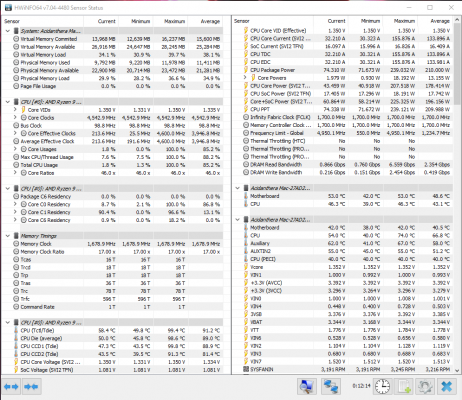Post your overclocks !
- Thread starter bottle
- Start date
You are using an out of date browser. It may not display this or other websites correctly.
You should upgrade or use an alternative browser.
You should upgrade or use an alternative browser.
More of an optimisation rather than an overclock considering I am on a laptop with Ryzen 4800H and RTX2060. I have reduced the CPU TDP to get more out of the GPU and quite content with the gains. Screenshots below are from TimeSpy and FireStrike at 1080p with my settings on the left and stock on the right.

Last edited:
thegr8anand
Forerunner
Use the curve mode in bios with PBO+ instead of a hard oc like this.If you are running it at 1.4v don't!!! it will reduce your cpu life severely. I have mine 4.6 at 1.3v with llc 3 and anything above requires way more voltage.
thegr8anand
Forerunner
AMD processors are good with 1.4v as much I know. my phenom x II 1055t is still live and heathy. plus I think its totally depends on the temperature. right now they are fine and so no issue i supposeIf you are running it at 1.4v don't!!! it will reduce your cpu life severely. I have mine 4.6 at 1.3v with llc 3 and anything above requires way more voltage.
 correct me if I am wrong
correct me if I am wrong 
thegr8anand
Forerunner
No brother. Can't compare different generations and voltages matter as a lot with these newer cpus. Just Google ryzen 2nd/3rd gen safe voltage. If you are pumping 1.4v at 100% load believe me your cpu life will degrade very fast. Have read a lot about this as have had 3900x and now 5900x. Trust me those 100mhz are not worth the 1.4v
truegenius
Explorer
it depends on process node, phenom 2 were 45nm and many had 1.4v as stock voltage.AMD processors are good with 1.4v as much I know. my phenom x II 1055t is still live and heathy. plus I think its totally depends on the temperature. right now they are fine and so no issue i supposecorrect me if I am wrong

For smaller node the voltage have to be lower for longevity.
Some more tips
More important than the average core voltage is peak core voltage, if your cpu is idle ( running at lower clock and voltage to save power) and then you apply some load then the transient response will be worse and cause voltage to over shoot ( it can go 1.7v+ if you set 1.4v load voltage and if it idles down to say 1v ) for micro second which cause silent degrade or even dead cpu or board if vrm is bad. So i will recommend to turn off dynamic voltage ( that is voltage never idles down ) so that vrm doesn't need to overcompensate for the sudden load.
Also always use LLC to introduce intentional voltage droop, that is your max load voltage should always be lower than your idle voltage. ( eg 1.35v at idle, and 1.25v at 100% load ) this is to avoid spikes during transient, as those spikes will go much above your desired load voltage. These can only be seen via oscilloscope, AHOC ( buildzoid ) have several videos regarding these.
1.3v for 4600mhz recenty crashed my systemNo brother. Can't compare different generations and voltages matter as a lot with these newer cpus. Just Google ryzen 2nd/3rd gen safe voltage. If you are pumping 1.4v at 100% load believe me your cpu life will degrade very fast. Have read a lot about this as have had 3900x and now 5900x. Trust me those 100mhz are not worth the 1.4v

is this regardless of low temp ?it depends on process node, phenom 2 were 45nm and many had 1.4v as stock voltage.
For smaller node the voltage have to be lower for longevity.
Some more tips
More important than the average core voltage is peak core voltage, if your cpu is idle ( running at lower clock and voltage to save power) and then you apply some load then the transient response will be worse and cause voltage to over shoot ( it can go 1.7v+ if you set 1.4v load voltage and if it idles down to say 1v ) for micro second which cause silent degrade or even dead cpu or board if vrm is bad. So i will recommend to turn off dynamic voltage ( that is voltage never idles down ) so that vrm doesn't need to overcompensate for the sudden load.
Also always use LLC to introduce intentional voltage droop, that is your max load voltage should always be lower than your idle voltage. ( eg 1.35v at idle, and 1.25v at 100% load ) this is to avoid spikes during transient, as those spikes will go much above your desired load voltage. These can only be seen via oscilloscope, AHOC ( buildzoid ) have several videos regarding these.
1.4v long term will fry your cpu irrespective of temperatures.1.3v for 4600mhz recenty crashed my system
is this regardless of low temp ?
Stronk
Herald
Stronk
Herald
truegenius
Explorer
yes, specially voltage spikes as temp won't increase due to those mili/microsecond spikes1.3v for 4600mhz recenty crashed my system
is this regardless of low temp ?
burntwingzZz
Innovator
so did any one try newer version of clocktuner 2.1 , takes 4 to 6 cores of zen 3 slightly beyond 5ghz
thegr8anand
Forerunner
Those clocks are meaningless tbh. Not one task will actually happen at that ghz. That is just idle boost.so did any one try newer version of clocktuner 2.1 , takes 4 to 6 cores of zen 3 slightly beyond 5ghz
I went back to 4.2ghz for alot of time back. today did a 4.6ghz and a 10 min CR23 run test which gave me below test. everything was fine, just the temps are scary. 99.4 degree on a 360mm liquid cooler  I am lost
I am lost 

Attachments
Managed to OC my 2133 Mhz DDR4 HyperX Fury Ram to 3000 at CL16 , was quite surprised i could push it this far
Kratos47
Forerunner
At what voltage?Managed to OC my 2133 Mhz DDR4 HyperX Fury Ram to 3000 at CL16 , was quite surprised i could push it this far







